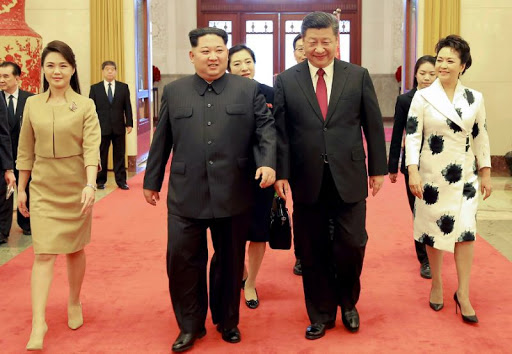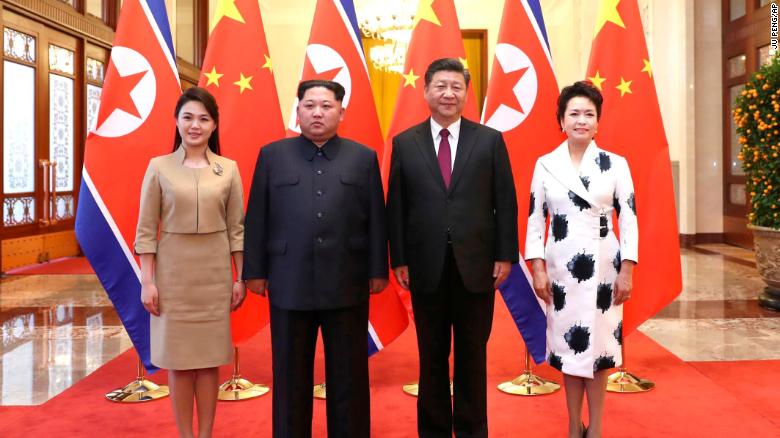BY: Danieal Ranjbar

PEJOURNAL – China-US relations have many complexities and dynamics due to the need of both sides to take advantage of mutual capacities. The United States and China are partners as well as rivals. They are rivals in geopolitics and partners in economics. Their cooperation and contradictions become apparent, one of the most important of which is North Korea; China is helping North Korea maintain a strategic buffer zone against US influence. In studies of China-US competition, most researchers have focused on economic issues and less on geostrategic issues and the role of a third player in these relationships and competition; in this article, all efforts are to show how the North Korean crisis can be important in US-China strategic competition.
Importance of North Korea for US & China
North Korea is important to both China and the United States. China’s neighbor is on the rise, and in addition, it has taken successful steps towards full nuclearization and the construction of nuclear weapons and long-range missiles, and this may not be good for the United States. N. Korea’s policy could directly threaten national security and even the survival of US strategic partners Japan and South Korea, and destroy US strategic bases in those countries. The nuclearization of a so-called insurgent state, in the eyes of the United States, undermines its global authority and prestige, and casts doubt on Washington’s partners in its ability to protect them from other countries’ threats.
On the other hand, China, which is on the path of superpower and reaching the position of great world power, is facing harassment from the United States; Therefore, it needs different pressure tools against this country that it can use as a trump card against the United States, and North Korea can play this vital role, but it should be noted that China only intends to use North Korea as a tool against the United States, and he himself has no interest in making this unpredictable neighbor stronger.
China – US Economic Relations
Trade relations between the two countries increased rapidly immediately after the establishment of diplomatic relations in January 1979. As a result both countries wrote bilateral agreements. In 1979, when China began its economic reforms, the total China-US trade (exports and imports) was $2 billion. In 2015, total bilateral trade was estimated at $659 billion, of which about $161 billion were exports to China and about $498 billion were imports from China. In 2013, China was the second largest US trading partner after Canada, it has been the third largest export market for American products (after Canada and Mexico) and the largest exporter to the United States.
In 2015, China became the largest US trading partner, but remained the third largest export market for US products, indicating that China’s exports to the United States increased. The US Treasury Department estimates that US exports to China in 2014 created and maintained approximately 251,000 jobs in the United States. The main concern of many American politicians is the size of the trade deficit with China. The trade deficit increased from $10 billion in 1990 to $266 billion in 2008 and finally to $324 billion in 2013. This amount has continued its upward trend and has increased to $343 billion in 2014 and $367 billion in 2015.
Bilateral investment has also been a major part of US-China trade relations. Chinese investments in the United States are divided into several groups, including securities assets, foreign direct investment, and other non-loan investments. The Chinese purchase of Treasury bonds increased from $118 billion in 2002 to $3.1 trillion in May 2013. Thus, China has become the largest buyer of US bonds. The amount of foreign direct investment between China and the United States is significant. China’s direct investment in the United States has jumped sharply since 2010, from about $1.6 billion to $47.9 billion in 2014.
China – North Korea Relations
Over the past decades, China and North Korea have had friendly relations. China’s intervention in the Korean War almost prevented the imminent death of the North Korean government. China maintained its forces in North Korea in the post-war years until 1958. In 1961, North Korea and China signed the Treaty of Friendship, Cooperation and Mutual Assistance. As Soviet-North Korean relations cooled, North Korea maintained active relations with China. In the early 1960s, then-North Korean leader Kim Il-sung supported China during the Cuban Missile Crisis and the 1962 China-India border dispute.
The differences and common identities between the two governments were enough to ensure the continuation of relations between the two countries for decades. But the two blood relatives gradually fell apart in the early 1980s, when China began economic reforms and free market mechanisms led by Deng Xiaoping, and when Beijing established full diplomatic relations with South Korea in 1992. Despite these differences, formal relations improved and economic flows increased in the early 2000s, with China emerging as North Korea’s main trading partner in 2009.
In 2011, North Korea’s trade with China accounted for 60% of North Korea’s total foreign trade. Chinese tourists who have traveled to North Korea are an important source of foreign exchange. In 2011, 60,000 to 70,000 tourists visited North Korea. North Korea’s economic dependence on China increased after the collapse of the Six-Party Talks in 2009; Trade between the two countries increased from $6.2 billion in 2009 to $6.5 billion in 2011 and $86.6 billion in 2014.
North Korea: China’s security buffer
Tens of thousands of North Koreans live near China’s northeastern borders, and political unrest in North Korea, economic collapse, and war with the United States have sent many Koreans to China. Following the ballistic missile test in July 2006, China increased its border forces to prevent the entry of refugees. China in general has concerns about North Korea that we can mention some of these concerns here.
1. Prevent the collapse of the ruling regime and create insecurity in China’s periphery: China’s top priority on the Korean Peninsula is to prevent political change and economic collapse in North Korea, as it has far-reaching consequences for China’s economic and social stability. Under these circumstances, international pressure on North Korea will increase and a military confrontation on the Korean Peninsula will be possible. These concerns are the main reasons behind China’s support for Pyongyang through energy and food aid and its opposition to any sanctions that make things worse for Pyongyang than ever before.
2. Prevent mass migration: China has a 1,416-kilometer permeable natural border with North Korea. Instability in the country could lead to a flood of hundreds of thousands of refugees fleeing to China. China is concerned that small groups of militants may enter the country along with the refugees, creating social, political and security problems for the refugees.
Conclusion
According to Chinese politicians, foreign policy strategy should be able to provide an external space for China to expand, grow and develop. In the eyes of Chinese officials, there is a kind of distrust of the international environment and China’s economic interests. At the same time, they are trying to refrain from resorting to war to accelerate economic growth. China’s leaders believe that diplomacy can provide good opportunities for economic development. China is trying to present its military threats against the United States through North Korea. In fact, North Korea is a proxy actor from China that responds to US belligerent behavior in the East Asian region so that China can get closer to its long-term economic goals.
China and the United States only use different levers to put pressure on their rivals to prevent the other side from operating freely. To avoid a direct conflict, they intend to put pressure on each other through the smaller countries in the region. At the instigation of South Korea, Japan, and sometimes Australia, the United States seeks to gain concessions from China, and China seeks to establish a regional balance and curb US demands in East Asia by relying on North Korea’s nuclear weapons.
